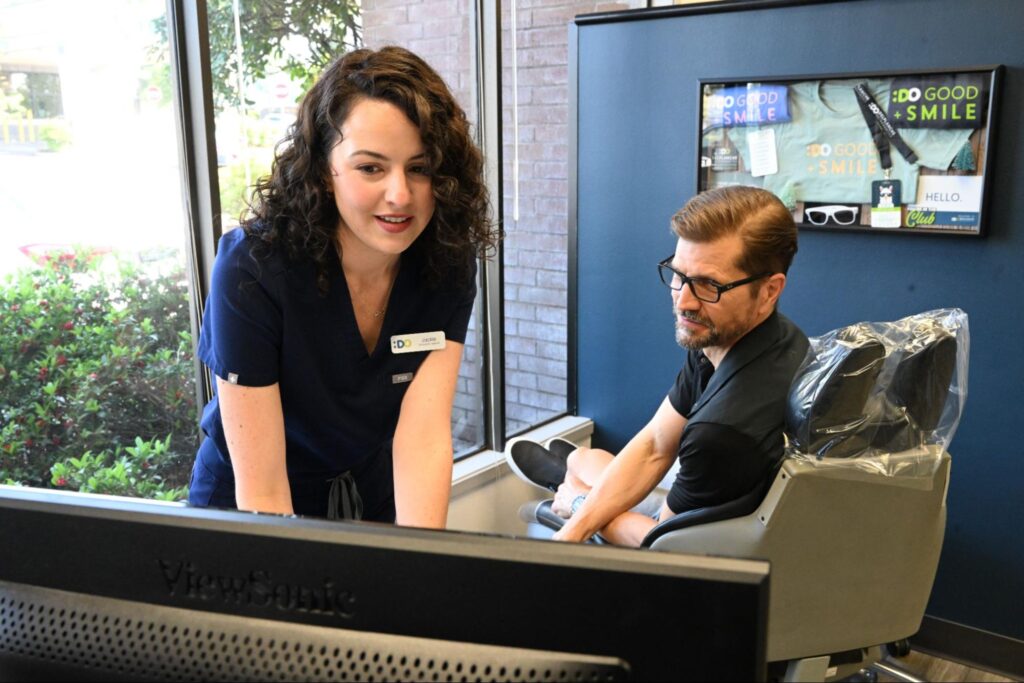“What is the difference between aligners and retainers?” is a question we hear almost daily at Delplanche Orthodontics. It’s a great one, as both play pivotal parts in creating straight smiles in different ways, and we’re happy to help.
First Things First: What Is Bone Remodeling?
Before we dive into the differences between aligners and retainers, we first need to have an Orthodontics 101 crash course. We promise it will help you understand aligners and retainers, so don’t scroll past this section!
Bone remodeling is a crucial process during orthodontic treatment, triggered by the pressure from orthodontic appliances. When orthodontic devices like aligners (or traditional metal braces or clear braces) apply pressure, they stimulate the bone surrounding the teeth to remodel, adapting to the new dental alignment.
Basically, on one side of your tooth, the bone breaks down to allow for movement. On the other side, it reforms to hold teeth in their new places.
Now, with that in mind, let’s talk about aligners and retainers.

So, What Are Aligners?
Invisalign, the aligner system offered by Delplanche Orthodontics, represents a cutting-edge approach to orthodontics. Unlike traditional braces, clear aligners are crafted from a transparent, flexible plastic that is safe and comfortable. These aligners are custom-made using 3D printing technology, guaranteeing a perfect, individualized fit that snugly covers your teeth.
One of the most appealing aspects of clear aligners is their convenience—they can be removed for eating, brushing, and flossing. This feature significantly simplifies maintaining oral hygiene and allows you to enjoy your favorite foods without worry.
Straightening teeth with Invisalign is a little different than metal and clear braces. Instead of wires and brackets, clear aligners involve a series of these 3D-printed trays, each slightly different from one another, to make small adjustments to the function of your teeth. Every three days to two weeks, as prescribed by Dr. Delplanche, you switch to a new set of aligners, which continues the movement of your teeth toward their final, correct positions. This gradual, controlled technique, custom fit, and clear design help achieve the desired results with minimal discomfort and visibility.

Then What Are Retainers?
Like aligners, most retainers can be removed for eating, drinking, and oral hygiene. Some retainers, like essix retainers, also look like clear aligners. But they have different purposes!
Retainers come into play after the active treatment has been completed, which is the time period of wearing the braces or aligners. They have a very important role of keeping your teeth in their new positions.
Why do you need retainers to hold your teeth in place? Remember the bone remodeling process we talked about a second ago? Well, it doesn’t happen overnight.
When we complete the active treatment phase, it’s because we’re happy with your alignment and don’t need to move your teeth anymore. However, the bone in your jaw hasn’t finished reforming yet! Teeth have excellent memories and are very nostalgic. If given the time and room, your teeth will try to return to their original alignment. You might not notice it right away, but overtime, your teeth will slowly shift back to the positions they were in before treatment, therefore Dr. Delplanche recommends retainer wear for life!
This is why wearing a retainer, whether a wire Hawley retainer, a nearly invisible essix retainer, or a fixed retainer, is critical to protecting your orthodontic investment and new smile. Retainers retain your teeth and keep them from moving.
It’s essential to wear and care for your retainer, as instructed by Dr. Delplanche. You don’t want to have to restart treatment again—yes, that is a possibility!
How Long Do You Wear Them?
You’ll be happy to know that you won’t have to wear your Invialign aligners or braces for forever! Depending on the complexity of your case, Invisalign aligner treatment can be concluded in as little as six months! On average, treatment at Delplanche Orthodontics is 12 months in length.
Retainers, on the other hand, are your new best friend! You’ll likely need your retainer for the rest of your life. But please don’t let that discourage you! We promise it’s not as bad as it sounds.
Let’s break it down:
- In the beginning, you’ll need to invest time in creating a new habit of wearing your retainer. Consider how you currently manage your oral hygiene. Add some extra time to clean your retainer and keep it in a safe place near your toothbrush, toothpaste and floss.
- After a while, you’ll have a new routine of wearing it nightly, just like you brush your teeth every night around bedtime.
- If all goes well, your retainer will become a regular part of your nightly routine, and you will have a long-lasting, beautiful and well-functioning smile!
It’s a small price to pay to have a smile you love showing off!

Delplanche Orthodontics Is Here For All Your Questions!
We’re passionate about patient education at Delplanche Orthodontics. We believe that the more you know, the more confidence you can have when making decisions about your treatment and oral health. If you want to learn more about aligners, retainers, insurance, or braces, give us a ring! Our teams in Beaverton and Lake Oswego are always willing to lend a helping hand.
